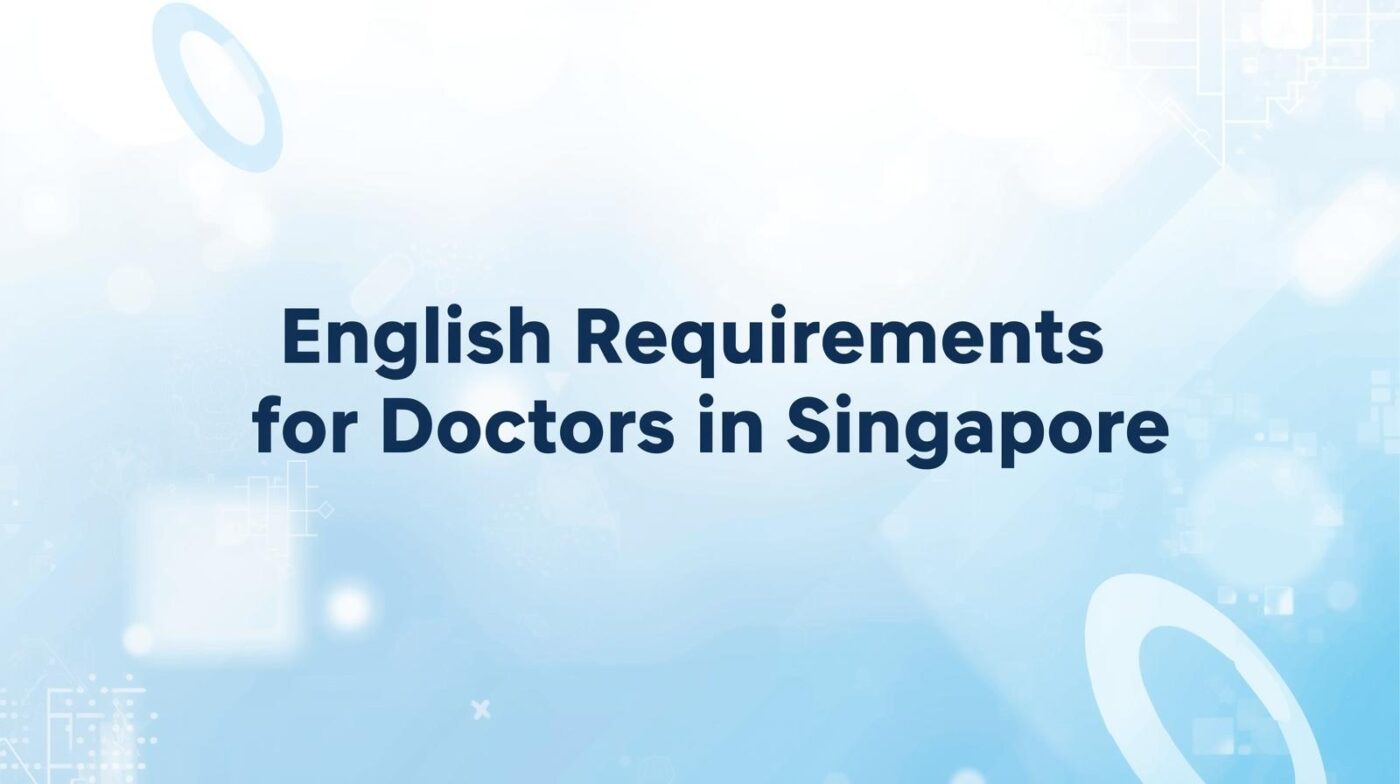Registration & Pathways
English Requirements for Doctors in Singapore (Latest Guide)
Have you ever thought about working as a doctor in Singapore?
In fact, if you meet certain criteria, IMGs can obtain registration and work as doctors in Singapore.
Among these requirements, one of the biggest hurdles for many applicants is English proficiency.
This article explains in detail the level of English required to practice medicine in Singapore, and how to reach it efficiently.
Required English Proficiency and Study Options
According to the Singapore Medical Council (SMC), there are three accepted options for proving English proficiency:
- OET: Minimum Grade B in all sub-tests (equivalent to 350 points)
- IELTS: Minimum 7.0 in each band
- TOEFL iBT: Total 100, with at least 25 in each section
Reference: Evidence of English Proficiency – Singapore Medical Council
With three different options, it can be difficult to decide which test to take. While it’s fine to choose the one you feel most motivated to study for, the reality is that the difficulty levels differ significantly.
(For other requirements related to medical registration in Singapore, please refer to our separate article.)
Let’s now take a closer look at each option.
About the Tests
| OET | IELTS | TOEFL iBT | |
|---|---|---|---|
| Format | Paper or computer-based | Paper or computer-based | Computer-based |
| Fee | AUD 587 | USD 250 (varies by country) | USD 195 |
| Score Range | 0–500 | 0–9 | 0–120 |
| Average (Japan) | N/A | 5.8/9 | 72/120 |
| Test Time | ~3 hrs | ~3 hrs | ~2 hrs |
| Sections | Listening (40m), Reading (60m), Writing (45m), Speaking (20m) | Writing (60m), Reading (60m), Listening (40m), Speaking (11–14m) | Reading (35m), Listening (36m), Speaking (17m), Writing (29m) |
Each test originates from a different country: OET from Australia, IELTS from the UK, and TOEFL from the US — so the accent and vocabulary style differ accordingly.
All three are offered regularly across major cities worldwide, often several times per month — and IELTS is available almost every day in many regions.
Results are typically released within 10 days for OET, 1–3 days for IELTS, and 4–8 days for TOEFL.
OET is designed specifically for healthcare professionals, testing only medically relevant topics.
TOEFL is aimed at academic settings, with more scientific and technical content.
IELTS covers a wider range of topics, suitable for both study and work abroad.
Required English Level
So, what level of English is actually needed to work as a doctor in Singapore?
The required standard is relatively high — roughly equivalent to upper-advanced proficiency, where you can handle complex professional discussions, write clear reports, and interact naturally with patients in English.
For context, candidates who score around OET 300, IELTS 6.5, or TOEFL 80 are already competent English users.
However, Singapore’s minimum requirement — OET 350, IELTS 7.0, or TOEFL 100 — represents the level of a confident, professional communicator in healthcare.
It’s a demanding standard, but absolutely achievable with structured preparation.
The truth is, this level of proficiency is necessary to function confidently and safely in an English-speaking clinical environment.
Which Test Should You Take?
All three tests can help improve your English. However, if we had to recommend an order of preference, it would be:
OET > IELTS > TOEFL
Here’s why:
- OET offers the most direct benefit for IMGs — it uses real clinical scenarios that help you prepare for actual patient communication. Many test-takers also find it easier to reach the target score compared to IELTS or TOEFL.
- IELTS is versatile, but achieving a 7.0 in both Speaking and Writing can be particularly challenging. Many candidates get stuck around 6.5 for months.
- TOEFL requires consistent high performance (25+ in each section), which demands strong overall English skills across reading, writing, listening, and speaking.
If your goal is to work in a healthcare setting, OET provides both practical language skills and motivation through relevant content.
Effective Study Path
To progress efficiently, the recommended learning pathway is:
General English → IELTS (Overall 6.5) → OET
This sequence allows you to build solid foundations before specializing in medical English.
Before starting OET preparation, you’ll need at least a high-school to upper-intermediate level of English. If you’re unsure, start by reviewing grammar, reading comprehension, and core vocabulary.
Once your foundation is stable, move on to IELTS.
Why not start directly with OET? Because OET materials are limited. IELTS offers far more graded resources, making it easier to improve step by step.
Focus on official IELTS practice books, starting with those that include explanations or sample answers if needed.
For Speaking and Writing, prioritize fluency and clarity over grammatical perfection — practice expressing ideas spontaneously and naturally.
Mastering Clear Pronunciation
If you plan to work overseas, improving your pronunciation is essential.
Although most English exams state that “having an accent does not reduce your score,” misinterpretation of this statement can be risky.
In real settings, unclear speech can lead to misunderstanding — or worse, errors in patient care.
Everyone has a natural accent, and that’s perfectly fine. But the key is intelligibility — how easily your listener can understand you.
In healthcare, clarity is a matter of safety.
Work on both phonetics (vowels and consonants) and prosody (stress, rhythm, and intonation) so your speech is clear and confident.
Study with OET BANK
Stop wasting time comparing OET materials.
With OET BANK, you get:
- Premium-quality OET materials, built by professionals
- A focused, efficient study path — no unnecessary content
- A system designed to help you pass OET once — without trial and error
If you want to prepare properly and pass with confidence,
you don’t need to look anywhere else.
Pick your materials and start today — with OET BANK.




